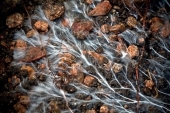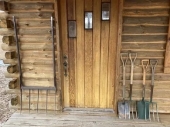Mycelial networks that flourish throughout a fertile garden, will transport what is needed from one place to another. They will transport minerals, other life forms, even communications. I likened it to being a microbial superhighway and fiber optic system. Each kind of plant relates to the system in unique ways. Certain microbes, will symbiotically relate, to only certain plants. Each kind of plant is mining a unique mineral makeup, and has root exudates, that are unique as well. This is why the more diverse your garden is the more resilient it is. There is more complexity available to share back and forth as needs arise.
Now I want you to look at my Quilt Garden pictures for a moment. I want you to pretend that each of those 6’x6’ squares, of different crops, are unique "nations" of different people groups. We understand that Japan, Ireland and Brazil are all very different. The people that live in those countries have been uniquely shaped by the land and the resources that are there. To the extent that a certain group of people can learn to utilize their particular resource base, in a productive way, is very important. Each country has certain needs they have to trade for, from regions that have that particular resource in abundance. We understand how this works, between countries and different people groups. Great systems of communication and transportation have been developed in order to facilitate this important trade.
Now as I design my garden, I am in a sense creating a whole world. In one teaspoon of well made compost, there can be six billion microbes. So from a microbial standpoint, that 6’x6’ area is enormous. But if I am savvy with the plants I use, and the different mulches and soil amendments I incorporate, I can create very unique “nations” that have a good resource base in which to be productive, and have enough of their “unique resource” so they can trade with other nearby “nations” that need what they have. And vise versa. Just as our world had to develop the proper communication and transportation networks to facilitate world wide trade, so must you in order for this to work in the “world” you are attempting to make. But if this mycelial network, that facilitates the trade and communication is vital to all of these “nations” being able to trade with one another, then it is critical that you understand how to feed that network, so it can thrive and be fully functional.
One of the favorite foods for the beneficial mushroom mycelia that our plants relate to is wood chips. But there is something you need to understand about wood chips. Depending on where they come from the tree, makes a huge difference on how successful you will be in your mycelial garden development plans. Chips that are made from the trunk wood, like the kind of wood we make furniture out of, will have a carbon: nitrogen (C:N) ratio of around 700:1. That is why we make furniture from it. Very strong carbon chains, that would require a huge amount of nitrogen to break them down. If you mix wood chips made from this wood into your soil, your plants will struggle for years. Those chips will always be stealing the extra nitrogen that will be present in order to decompose them.
The chips that you want, that are like prime rib to white rot fungus, are from the fine branches. The C:N ratio of a branch that is 2 3/4” and smaller is around 40:1. To those of you that are experienced with making compost, 40:1 is an ideal ratio to shoot for to get a good active pile. So what this means, is that when you make chips out of the smaller branches, you are basically spreading compost on your soil. It isn’t going to steal from your soil, but be giving tremendously. Deciduous tree branches are very mineral dense. The very best deciduous species to harvest are ones that have a lot of understory growth of other species. Maple, oak, cherry, beech are among my favorites for our area.
Something you need to understand though, is that there is a prime time to harvest them. In the fall, when the trees have dropped their leaves, most of the minerals have been transferred from the leaves back to the branches. Stored there until the following spring, when new leaves begin to develop. You want to harvest these Ramial branches, (the name the researchers gave to these specific branches at the University of Laval, in Quebec), when the trees are dormant. During this period they are the best fungal food. If you harvest the branches when they still have green leaves on them, they will be predominately consumed by bacteria. Bacteria are super easy to produce. Mycelial networks are not. By using the branches when they are dormant, you give the mycelia an advantage to colonize them first. Especially if you apply them in the fall, and give the mushrooms a chance to work on them while the bacteria are more dormant during the winter. Mushrooms will stay active, at much lower temperatures than most bacteria.
When you make these chips though, you need to make sure you chip them as fine as you can. A chipper, shredder unit that has hammers, will usually do the best job. Reducing them down to about 1/4” and smaller. The size will be determined, by the size holes that the screen has at the shoot that the chips are forced through. The smaller the holes on that screen, the longer they will stay in the hammers, to be broken up into even smaller pieces that are able to exit the unit. The smaller size is critical, because you are increasing the surface area, that the fungus will have to work on, making their job much more efficient.
So there are two kinds of chips I use in my garden. Larger chips made from deciduous tree “tops”. These are not true Ramial, because the branches were much larger. I use these chips on my service pathways. I have 4’ wide paths that go throughout my garden, where I can bring my garden cart to facilitate bringing in and out heavy loads. These chips are just spread on the surface. The true Ramial chips, I will use as a soil amendment, and stir right into the soil surface, as I am getting ready to transplant something.
So I have my 4’ wide paths, that are hundreds of feet long, all inter connected, that are just filled with mycelia. I have had mushrooms fruit over the whole pathway system at the same time. All interconnected and working together. The 4’ paths are the interstate highways, to transport goods and services throughout my garden. If your garden is small, you could create a zone around your garden, like a border, that had a wood chip mulch covering it. That would help facilitate these mycelial networks.
Someone might say to me, “why don’t you just cover your whole garden in wood chips?” Because it won’t be diverse enough, for the kind of “world”, I want to develop. You will see a picture at the end of this article, that shows my sweet potato Quilt plot mulched with rocks. Wood chip mulch, tends to cool the soil, which can be beneficial for many things, but not sweet potatoes, growing in Michigan. I also use hay from my pastures to mulch certain plants that prefer bacterial dominant soil. Others I mulch with dark compost to increase the warming effect from the sun. Catering mulches to plant "nation" preferences.
There is so much more I want to share with you, that is going to have to wait. But I do want to plant one more thought in your brain, to chew on. If you were going to transplant a group of Japanese citizen to a new location, would you send them to Greenland, with seed to grow corn? Of course not. You would transplant them to a location where they can continue to use their knowledge base and the resources they are accustomed to, to survive. Artic cold and corn, is not the resource base they are accustom too. As you look at every species of plant you want to have in your garden, you have to learn all you can about their preferences, and the things that hinder them. Wild blueberries in Michigan grow in an ecosystem of oaks, pines, bracken fern, moss to name a few. A mixture of these items would make an excellent mulch for a blueberry "nation". Especially if it was inoculated with leaf mold from a wild blueberry patch.
One of the pictures below shows a very unique “nation” I created, with a tropical plant, here in Michigan. Sweet potatoes desire a 85 degree soil temperature. That is not Michigan! So I mulched the full 6’x6’ area with small rocks. I had a soil thermometer there to check the soil, and it was often over 90 degrees. I had a wonderful harvest, with some rather large potatoes that came from that experiment. I will definitely do it again.
If you would like to do some further study on Ramial Chipped Wood this is the best article I have found.
https://www.dirtdoctor.com/organic-research-page/Regenerating-Soils-with-Ramial-Chipped-Wood_vq4462.htm









